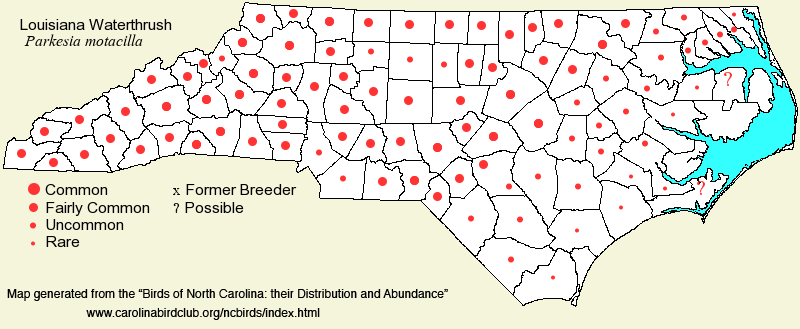 |  |
|
Louisiana Waterthrush - Parkesia motacilla PARULIDAE Members: | Search Common: Search Scientific: |
|
|
|||||||
| General Comments | The Louisiana Waterthrush is always a joy to watch as it teeters along a wooded creek, walking up and down the shoreline and at times wading into the shallow water. Also, because it arrive by mid-Mar in many area in the state, and has a beautiful song, it is one of the true "harbingers of spring". The species nests across nearly all of the eastern United States, though it is scarce in Florida and near the coastal areas farther north and west, in the breeding season. Numerically, it is not one of North America's more common species, as breeding territories are well-spaced along narrow streamside corridors. But, if the right habitat is found, the species can usually be seen and heard, though singing drops off sharply by late May. Breeding habitat is always along streams and rivers, under the shade of hardwood trees, and with near-vertical banks where the nests are placed. They favor slightly running waters of rocky creeks, as opposed to standing water of larger streams and rivers, but they can certainly be quite numerous along some of our larger rivers such as the Roanoke. | ||||||
| Breeding Status | Breeder | ||||||
| NC BRC List | Definitive | ||||||
| State Status | |||||||
| U.S. Status | |||||||
| State Rank | S4B | ||||||
| Global Rank | G5 | ||||||
| Coastal Plain | Summer resident, but scarcely noted in migration. Fairly common in the western and central portions along brownwater rivers and streams; mostly uncommon along blackwater streams. Breeds east to the Great Dismal Swamp area, Havelock (Craven), Newport (Carteret), and the Green Swamp (Brunswick); however, uncommon in most coastal counties, and rare to absent within about 10-15 miles of the coast, especially in New Hanover. Does not nest on the Outer Banks, and is very rare there even in migration; a scarce migrant where it does not nest. Mainly mid- or late Mar to late Jul; surprisingly few records after early Aug. Peak counts: | ||||||
| Piedmont | Summer resident. Uncommon to fairly common over essentially all of the region, though less numerous (uncommon) in some counties that are highly developed or highly agricultural. Mainly mid- or late Mar to mid-Aug, very rarely into Sep. Peak counts: | ||||||
| Mountains | Summer resident. Generally fairly common over the region, up to about 3,500 feet, uncommon to 4,000 feet, and absent over 4,500 feet. Mainly late Mar to mid- or late Aug, poorly known later. A report for 2 Jan 1954 for the "Smoky Mountains" (Pearson et al., 1959) is shocking, if correct; however, the species is seldom found in the state after mid-Sep, and thus the report probably represents a mis-identification. Peak counts: | ||||||
| Finding Tips |
The species should be found fairly easily in state parks, national forests, and various preserves in the western Coastal Plain, Piedmont, and lower mountains, especially in Apr. *** | ||||||
| Attribution | LeGrand[2023-04-03], LeGrand[2013-12-13], LeGrand[2013-11-11] | ||||||
| NC Map Map depicts all counties with a report (transient or resident) for the species. | Click on county for list of all known species. |
| NC Breeding Season Map Map depicts assumed breeding season abundance for the species. |  |